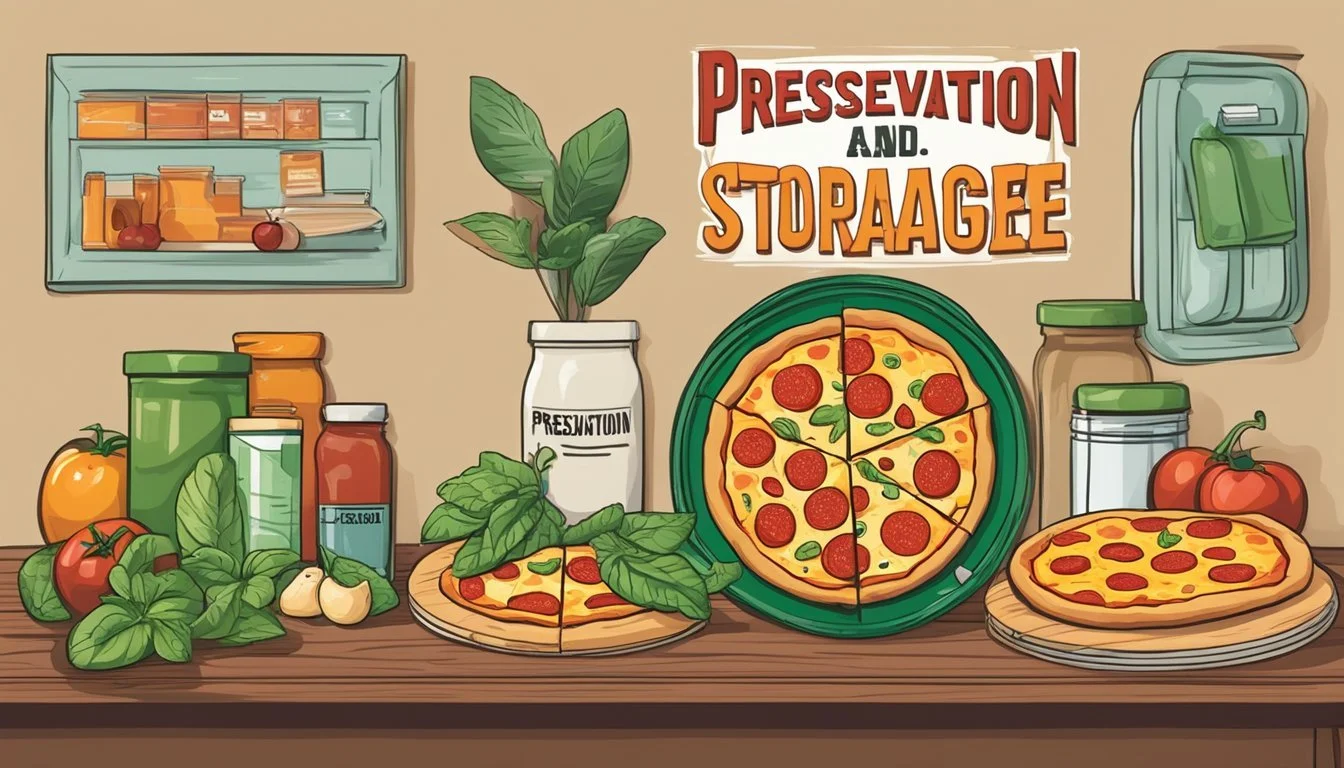Is Pepperoni Pizza Vegan?
Debunking Common Myths
Pepperoni pizza (What wine goes well with pizza?) is a staple in American cuisine, beloved for its spicy and savory toppings. Traditionally, this dish is not vegan due to its inclusion of pepperoni, which is made from cured meat such as pork or beef. Additionally, standard pizza often features cheese made from cow's milk, which is another non-vegan component.
However, the rise of plant-based diets has spurred the creation of vegan alternatives that mimic the flavors and textures of traditional pepperoni and cheese. Vegan pepperoni is typically made from a variety of plant protein sources, including soy, pea protein, or gluten. The creation of vegan cheeses has similarly evolved, using ingredients such as nuts, soy, and root vegetables to replicate the taste and melting properties of dairy-based cheese. Vegan pizza bases and sauces are readily available, as they usually contain no animal products unless modified for specific dietary needs or preferences.
As the market for vegan products expands, so does the accessibility of vegan pepperoni and cheese, making it easier than ever for individuals following a vegan lifestyle to enjoy a pizza that aligns with their dietary choices without compromising on taste.
Understanding Veganism
Veganism is more than just a diet; it's a lifestyle choice that excludes all forms of animal exploitation and cruelty. This section seeks to articulate what the term 'vegan' encompasses, how to assess whether ingredients are vegan, and what plant-based options are available for those seeking vegan alternatives to pepperoni pizza.
Defining 'Vegan'
A vegan diet includes only plant-derived foods, avoiding all animal products including meat, dairy, eggs, and even honey. Vegans also extend this philosophy beyond their diet, avoiding animal-derived materials and products tested on animals. A vegan pizza, therefore, would omit traditional toppings such as cheese and pepperoni and instead utilize ingredients that don't derive from animals.
Evaluating Ingredients for Vegan Compliance
When determining if an ingredient is vegan, one must consider its origins and processing methods. Ingredients must not be derived from any animal products, by-products, or involve animal testing at any stage. To ensure vegan compliance:
Meat: Must be excluded or replaced with mock meats made from plant proteins.
Cheese: Should be replaced with dairy-free cheese alternatives.
Other Ingredients: Should be scrutinized, as items like sauces may contain hidden animal products.
A comprehensive ingredient checklist could look like the following:
Ingredient Considered Vegan? Animal-Based Alternative Vegan Alternative Pepperoni No Pork, beef Plant-based pepperoni Cheese No Cow's milk Nutritional yeast, plant-based cheeses Sauce Usually May contain cheese or meat stock Pure tomato sauce or vegan-friendly varieties Dough Usually Some may contain dairy or eggs Vegan dough (water, flour, yeast, salt)
Plant-Based Alternatives
With veganism on the rise, the market has significantly expanded its offerings of plant-based substitutes that can mimic the taste and texture of animal products without using them. Vegan pepperoni pizza has become more accessible, with substitutes for pepperoni crafted from ingredients such as pea protein, soy, and wheat gluten. Vegan cheese options have also become more sophisticated, with various bases like cashews, almonds, and coconut oil providing creamy, meltable qualities. These plant-based alternatives are designed to offer vegans the experience of traditional dishes while aligning with their ethical and dietary choices.
Decoding Pepperoni Pizza
In understanding whether pepperoni pizza can be classified as vegan, it's crucial to scrutinize both the protein-centric topping and the traditional components that come together to create this ubiquitous dish.
Pepperoni: Meat-Based vs. Vegan Options
Traditional pepperoni is made from cured pork or beef, which clearly places it in the non-vegan category. However, the market has responded to the demand for plant-based diets by introducing vegan pepperoni. This alternative is constructed from non-animal sources such as pea protein, providing a similar flavor profile and texture to its meat-based counterpart.
Meat-Based Pepperoni:
Main ingredients: Pork, beef
Characteristics: Cured with spices
Vegan Pepperoni:
Main ingredients: Pea protein, rice, peas
Characteristics: Plant-based, often spiced to mimic traditional pepperoni
Pizza Ingredients and Veganism
The core components of a pizza include dough, tomato sauce, and cheese. For a pizza to be vegan, each ingredient must be free of animal products.
Dough and Crust: Typically vegan, made from flour, water, yeast, and salt. However, one should verify that no dairy or eggs have been added.
Tomato Sauce: Often vegan, given it is primarily tomatoes and seasonings. Nevertheless, some recipes may include non-vegan additives like cheese or meat flavors.
Cheese: Regular cheese is dairy-based, thus non-vegan. Vegan cheese substitutes are usually made with ingredients such as coconut oil, nuts, and soy.
The toppings beyond pepperoni can also make or break the vegan status of a pizza. Vegetables and certain meat substitutes are go-to choices for maintaining a vegan profile.
For those looking for a completely plant-based pepperoni pizza experience, it's essential to ensure that not only the pepperoni alternative is vegan but also the cheese, sauce, and dough.
Making Vegan Pepperoni Pizza
Creating a delectable vegan pepperoni pizza involves a few critical components: crafting vegan pepperoni, preparing a homemade dough, selecting dairy-free cheese and sauce, and mastering the baking process.
Vegan Pepperoni Recipes
Vegan pepperoni adds the quintessential spiced and savory flavor to the pizza. Most recipes utilize a base of tofu or vital wheat gluten for texture, and spices like fennel seeds, smoked paprika, and red pepper flakes to replicate the traditional pepperoni flavor. Once mixed, the vegan pepperoni is typically shaped into logs and steamed before slicing.
Homemade Vegan Pizza Dough
The foundation of any pizza is the dough. Vegan pizza dough requires only a handful of ingredients commonly including:
Yeast and Warm Water: Essential for fermentation and providing the dough with rise and airiness.
Flour: All-purpose or a mix with whole wheat for nutritional benefits.
Olive Oil: Adds a tender crumb and flavor.
Salt: For taste.
After mixing, the dough should be kneaded until smooth and left to rise, which usually takes about an hour.
Vegan Cheese and Sauce Options
For the topping, vegan cheese can be bought ready-made or homemade with ingredients such as cashews, nutritional yeast, and tapioca starch. Sauce options typically include tomato paste or a seasoned tomato sauce, which can be enhanced with herbs like oregano and basil.
Assembly and Baking Techniques
Constructing the pizza involves spreading the sauce evenly on the rolled-out dough, topping it with vegan cheese, and distributing vegan pepperoni slices across the top. For baking:
Preheat the oven to a high temperature, often around 400-450°F (200-230°C).
Bake for 12-15 minutes or until the crust is golden and toppings are heated through.
Servings, prep time, cook time, and total time vary depending on the recipe and oven type, but one can expect to spend roughly 20-30 minutes on preparation and 15-20 minutes on baking, totalling to an hour, accounting for dough rising. Vegan pepperoni pizza serves as a filling main course suitable for multiple servings.
Nutritional Considerations
When examining the nutritional profile of vegan pepperoni pizza, it proves insightful to compare its caloric content and distribution of macronutrients with traditional pepperoni pizza.
Caloric Content of Vegan Pepperoni Pizza
Vegan pepperoni pizza generally has lower calorie counts than its meat-containing counterpart due to the absence of high-calorie meat and cheese products. For instance, a slice of vegan pepperoni pizza might contain between 200 to 300 calories, while a traditional slice could range significantly higher, largely due to the fatty content of pepperoni and cheese.
Macronutrients: Protein, Fat, and Fiber
Protein: The protein content in vegan pepperoni pizza is usually lower than that found in traditional pepperoni pizza, as plant-based cheeses and meat substitutes typically have less protein than their animal-based analogues.
Source Protein (g per serving) Vegan Pepperoni 1-3 Traditional Pepperoni 5-10
Fat: Vegan versions often have reduced fat content, especially saturated fat, since plant-based toppings and cheese substitutes are generally lower in fat compared to traditional pork or beef pepperoni and dairy cheese.
Source Fat (g per serving) Vegan Pepperoni 2-4 Traditional Pepperoni 10-15
Fiber: Vegan pizzas can be higher in dietary fiber, particularly if a whole grain crust is used and the toppings include fiber-rich vegetables. This fiber is beneficial for digestion and can contribute to a feeling of fullness.
Ingredient Fiber (g per serving) Whole Grain Crust 3-5 Refined Flour Crust <1
Customizing Your Vegan Pepperoni Pizza
Creating a delicious vegan pepperoni pizza can be an enjoyable and creative culinary experience. It involves selecting an assortment of toppings, ensuring that the ingredients accommodate dietary restrictions, and presenting the dish in an appetizing way.
Alternative Vegan Toppings and Ingredients
A classic vegan pepperoni pizza begins with a base of vegan dough, smothered with a rich tomato sauce and sprinkled with vegan mozzarella. However, the toppings can extend far beyond just vegan pepperoni. For added texture and flavor, mushrooms and zucchini slices make great alternatives or additions. One can also explore a variety of other ingredients that enhance the pizza:
Olives
Artichoke hearts
Sliced bell peppers
Red onions
Jalapeños for a spicy kick
Pineapple for a sweet contrast
A drizzle of olive oil or a sprinkle of fresh basil to serve
Gluten-Free and Allergy-Friendly Options
To cater to gluten sensitivities, one can substitute traditional pizza dough with a gluten-free alternative made from rice flour, tapioca flour, or a gluten-free all-purpose blend. Ensure all other ingredients used, such as vegan cheeses and vegan pepperoni, are labeled gluten-free to prevent cross-contamination. Vegan mozzarella often contains soy, nut, or root-based starches; individuals with allergies must carefully check the labels.
Creative Serving Suggestions
The versatility of vegan pepperoni allows it to shine in a variety of dishes beyond pizza. One might fashion calzones by enclosing the pizza toppings (What wine goes well with pizza toppings?) within dough, creating a portable and delightful meal. Vegan pepperoni can also be diced and added to crackers for an impromptu charcuterie board or sliced into thinner strips for sandwiches. Serving the vegan pepperoni pizza with a side of marinara dipping sauce or garnishing it with fresh arugula could enhance the dining experience.
Preservation and Storage
Proper storage is crucial for maintaining the freshness and quality of vegan pepperoni pizza, whether it's leftover or homemade. Different techniques are employed to ensure the longevity of the pizza, preventing spoilage and preserving its taste.
Storing Leftover Vegan Pepperoni Pizza
When dealing with leftover vegan pepperoni pizza, one should store it in the fridge within two hours of baking to minimize the risk of bacterial growth. Individual slices should be placed in an airtight container or wrapped securely in aluminum foil or plastic wrap to retain moisture and prevent the absorption of other food odors. These slices can be kept in the refrigerator for 2-3 days.
Freezing and Refrigerating Homemade Vegan Pepperoni
Homemade vegan pepperoni has two main storage options: freezing or refrigerating. For short-term storage, refrigerating in an airtight container is advisable, and it will retain freshness for about a week. For long-term storage, freezing is the best option. One should:
Wrap the vegan pepperoni tightly in plastic wrap or aluminum foil.
Place the wrapped pepperoni in a freezer-safe bag or airtight container.
Label the bag or container with the date to keep track of its storage duration.
Frozen vegan pepperoni can be stored in the freezer for up to 6 months. To thaw, transfer it to the refrigerator overnight, ensuring it's ready to use without compromising texture or flavor.
Exploring Vegan Pepperoni Alternatives
When seeking vegan alternatives to pepperoni, two standout options are homemade seitan (What wine goes well with seitan?) pepperoni and commercial plant-based substitutes that echo the flavors of traditional meat-based pepperoni without using any animal products.
Homemade Seitan Pepperoni
Homemade vegan pepperoni often uses seitan as its base, a protein-rich food made from wheat gluten. To craft seitan pepperoni, one needs to knead vital wheat gluten with a blend of seasonings and spices that traditionally include black pepper, red pepper flakes, smoked paprika, cayenne, mustard, oregano, ground mustard, and fennel seeds to achieve the characteristic pepperoni flavor. The addition of liquid smoke, soy sauce or tamari, and balsamic vinegar imparts a depth of umami and a smoky touch that mirrors the taste profile of conventional pepperoni. Nutritional yeast may also be incorporated to enhance the savory notes typical to pepperoni. The mixture is then shaped into logs or patties and cooked, often through steaming or baking, to create a firm, sliceable texture.
Plant-Based Substitutes for Traditional Pepperoni
On the other hand, commercial plant-based substitutes for traditional pepperoni are made from a variety of bases, such as soy, tofu, tempeh, or chickpeas. These products are curated to replicate both the flavor and texture of traditional pepperoni. Companies use a blend of spices similar to the ones used in seitan-making, including but not limited to sea salt, fennel, black pepper, and red pepper flakes, coupled with meat-flavored plant-based ingredients to achieve the desired taste. The result is a product that is suitable for topping pizzas, adding into pastas, or even enjoying on its own, providing a cruelty-free alternative to meat-based pepperoni.






